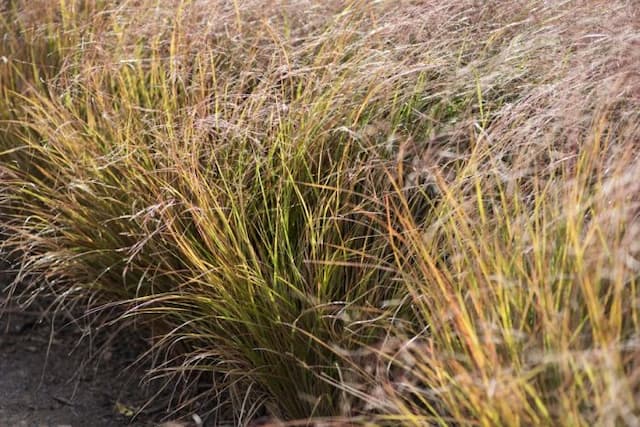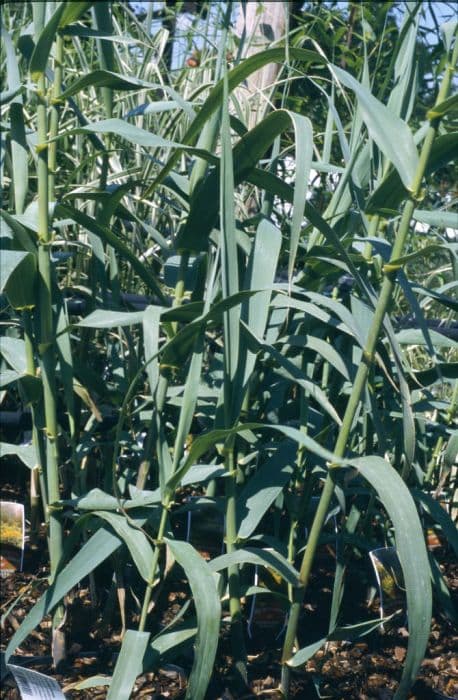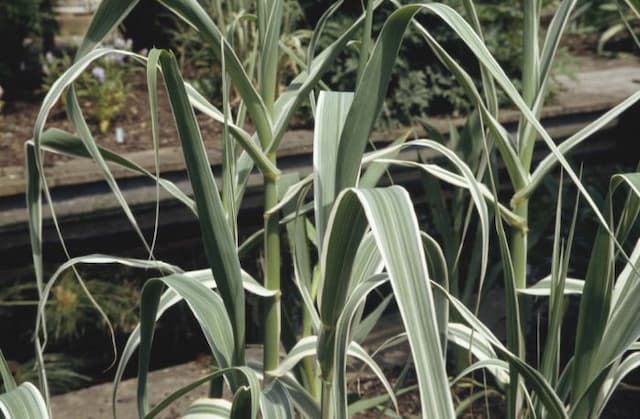Tiger Bamboo Phyllostachys nigra 'Boryana'











ABOUT
The plant in question is commonly known as the Tiger Bamboo, well recognized for its distinctive appearance. It features striking canes that start green before developing into a pattern that resembles tiger stripes, with a unique mix of dark brown spots and dashes against a lighter, tan-hued background. These markings become more pronounced as the plant matures, lending a dramatic and exotic look to the culms. The Tiger Bamboo's leaves are slender and lush green, adding a fine-textured look as they dangle gracefully from the canes. The overall growth habit is erect, with the canes tending to form tidy clumps. As it grows, the Tiger Bamboo offers a beautiful display of vertical lines and contrasting colors, making it a popular choice for ornamental displays in gardens that favor a touch of Asian flair or simply an exotic, eye-catching element.
About this plant
 Names
NamesSynonyms
Tiger Bamboo, Tortoiseshell Bamboo
Common names
Phyllostachys nigra var. boryana, Phyllostachys boryana.
 Toxicity
ToxicityTo humans
The plant known as Black Bamboo (Phyllostachys nigra 'Boryana') is not commonly regarded as toxic to humans. There are no well-documented cases or significant concerns regarding poisoning or toxicity from ingesting this plant. As with any non-food plant, it is advisable not to consume any parts of it as they may cause discomfort or be indigestible.
To pets
Black Bamboo (Phyllostachys nigra 'Boryana') is also not commonly considered toxic to pets such as cats and dogs. There is no significant evidence to suggest that it is harmful to pets if ingested. However, as with humans, it is always best to prevent pets from eating non-food plants since they could potentially cause gastrointestinal irritation or blockage.
 Characteristics
CharacteristicsLife cycle
Perennials
Foliage type
Evergreen
Color of leaves
Green
Height
20 feet (6 meters)
Spread
15 feet (4.5 meters)
Plant type
Bamboo
Hardiness zones
7
Native area
China
Benefits
 General Benefits
General Benefits- Aesthetic Appeal: Adds visual interest with its unique cane colors that transition from green to mottled tan or brown.
- Landscape Versatility: Can be used as a focal point, in group plantings or as a natural privacy screen.
- Growth Rate: Fast-growing, which allows for quick establishment and results in the landscape.
- Shade Production: Provides ample shade in garden spaces due to its dense foliage.
- Noise Reduction: Dense canes and foliage can act as a sound barrier, creating a quieter environment.
- Erosion Control: Strong root system helps stabilize soil and prevent erosion.
- Wildlife Habitat: Can serve as habitat for birds and insects.
- Durability: Resistant to pests and diseases, which reduces the need for chemical treatments.
- Culinary Uses: Young shoots are edible and can be used in various dishes (please note that culinary use may require preparation to ensure safety).
- Sustainable Material: Mature canes can be harvested for making furniture, crafts, and other sustainable products.
 Medical Properties
Medical Properties- This plant is not used for medical purposes.
 Air-purifying Qualities
Air-purifying QualitiesThis plant is not specifically known for air purifying qualities.
 Other Uses
Other Uses- Decorative Art Pieces: P. nigra 'Boryana' poles can be used to create unique art installations due to their striking black and green color pattern.
- Aquarium Decoration: Thin, cut pieces of the bamboo can serve as natural-looking, safe decoration in aquariums for fish to swim around.
- Sound Effects: The hollow stems can be used in making musical instruments or for special sound effects in theater productions.
- Culinary Tools: Bamboo culms can be crafted into utensils such as ladles, spatulas, and tongs for use in the kitchen.
- Walking Sticks: The sturdy canes can be fashioned into durable walking sticks for hiking and trekking.
- Fencing Material: Phyllostachys nigra 'Boryana' can be cut and used as natural fencing material, providing an aesthetically pleasing privacy barrier.
- Support Stakes: In gardening, the canes can be used as support stakes for other plants that require staking due to their stability and strength.
- Photographic Backdrops: Bamboo clusters can be used as a natural and textured backdrop for outdoor photography.
- Floral Arrangements: Dried segments of the bamboo can add an exotic look to floral arrangements or can be used as vases for small flowers.
- Bookshelves: Mature bamboo poles can be modified into bookshelves, adding a distinctive look to home libraries or living spaces.
Interesting Facts
 Feng Shui
Feng ShuiThe Black Bamboo is not used in Feng Shui practice.
 Zodiac Sign Compitability
Zodiac Sign CompitabilityThe Black Bamboo is not used in astrology practice.
 Plant Symbolism
Plant Symbolism- Strength and Flexibility: Bamboo, as a symbol, often represents both strength and flexibility, embodying resilience as it bends without breaking.
- Growth and Renewal: As a rapidly growing plant, bamboo embodies the idea of rapid growth and constant renewal, signifying new beginnings and fresh starts.
- Good Fortune: In many Asian cultures, bamboo is considered a symbol of good luck and fortune, often used in rituals and as a household plant to bring prosperity.
- Longevity: Due to its enduring nature and evergreen qualities, bamboo is also associated with longevity and immortality.
- Peace and Tranquility: The rustling leaves and the sturdy yet peaceful demeanor of bamboos represent calmness and tranquility in a chaotic world.
 Water
WaterFor the Black Bamboo, a consistent watering schedule is important. It should be watered deeply every week with about 2 gallons of water per plant. During hot or dry weather, increase the watering frequency to twice per week, ensuring the soil remains moist but not waterlogged. In cooler weather, you can reduce watering to when the top inch of soil feels dry to the touch. Always allow the water to soak into the soil rather than just wetting the surface.
 Light
LightBlack Bamboo thrives best in full sun to partial shade. It can tolerate direct sunlight, but in extremely hot climates, it should be provided with afternoon shade. The ideal spot is one where the plant receives a minimum of four hours of sunlight per day.
 Temperature
TemperatureBlack Bamboo can survive in a range of temperatures; from about 0 degrees Fahrenheit to over 100 degrees Fahrenheit. However, the ideal temperature range for this bamboo is between 30 and 80 degrees Fahrenheit. It is hardy and can endure the cold, but proper mulching can help in extremely low temperatures to prevent freezing of the root system.
 Pruning
PruningPruning Black Bamboo is mainly for thinning out older canes and controlling spread. Annually remove any canes that are older than three years to encourage new growth and maintain plant vitality. The best time for pruning is late winter before the growing season begins. This routine ensures the plant remains healthy and aesthetically pleasing.
 Cleaning
CleaningAs needed
 Soil
SoilThe Tibetan Black Bamboo prefers a well-draining soil mix with loam and sand; compost can be added for fertility. Soil pH should be mildly acidic to neutral, ranging from 6.0 to 7.0.
 Repotting
RepottingTibetan Black Bamboo typically requires repotting every two to three years, as it is a fast-growing plant that can quickly become root-bound in a container.
 Humidity & Misting
Humidity & MistingTibetan Black Bamboo thrives in moderate to high humidity conditions, aiming for a relative humidity of around 40-50%.
 Suitable locations
Suitable locationsIndoor
Place in a bright spot, water regularly, and ensure high humidity.
Outdoor
Plant in a sunny area, protect from harsh winds, and water deeply.
Hardiness zone
7-10 USDA
 Life cycle
Life cyclePhyllostachys nigra 'Boryana', commonly known as Bory Bamboo, begins its life as a dormant rhizome, which sprouts in spring to produce new culms (bamboo shoots). These shoots rapidly elongate within a few weeks or months using resources stored in the rhizome. Once the shoots reach their full height, they harden off and become woody, turning into the bamboo canes that are used for various purposes. The canes continue to grow in diameter and develop branches and foliage. Bory Bamboo can live for many years, and the clump expands as the root system produces new rhizomes, which will produce new shoots annually. This bamboo typically reaches maturity and can start flowering after several decades, but flowering is rare and can lead to the decline or death of the parent plant.
 Propogation
PropogationPropogation time
Late Spring to Early Summer
The most common method of propagation for the Black Bamboo, formally known as Phyllostachys nigra 'Boryana', is through division. This process involves separating a portion of the mature plant's rhizome, which is the underground stem, from the parent plant during the early spring before new growth begins. The section of the rhizome should include at least one or two growing points or 'culm buds'. After cutting the rhizome segment with a sharp spade, which should be about 12 to 24 inches (approximately 30 to 60 centimeters) in length, it should be immediately replanted in a prepared hole with adequate space for root development. The area where the new division is planted needs to be kept moist, ensuring that the soil does not dry out, facilitating the establishment of the new bamboo plant. This method is effective for expanding the garden or creating new plantings of Black Bamboo.









